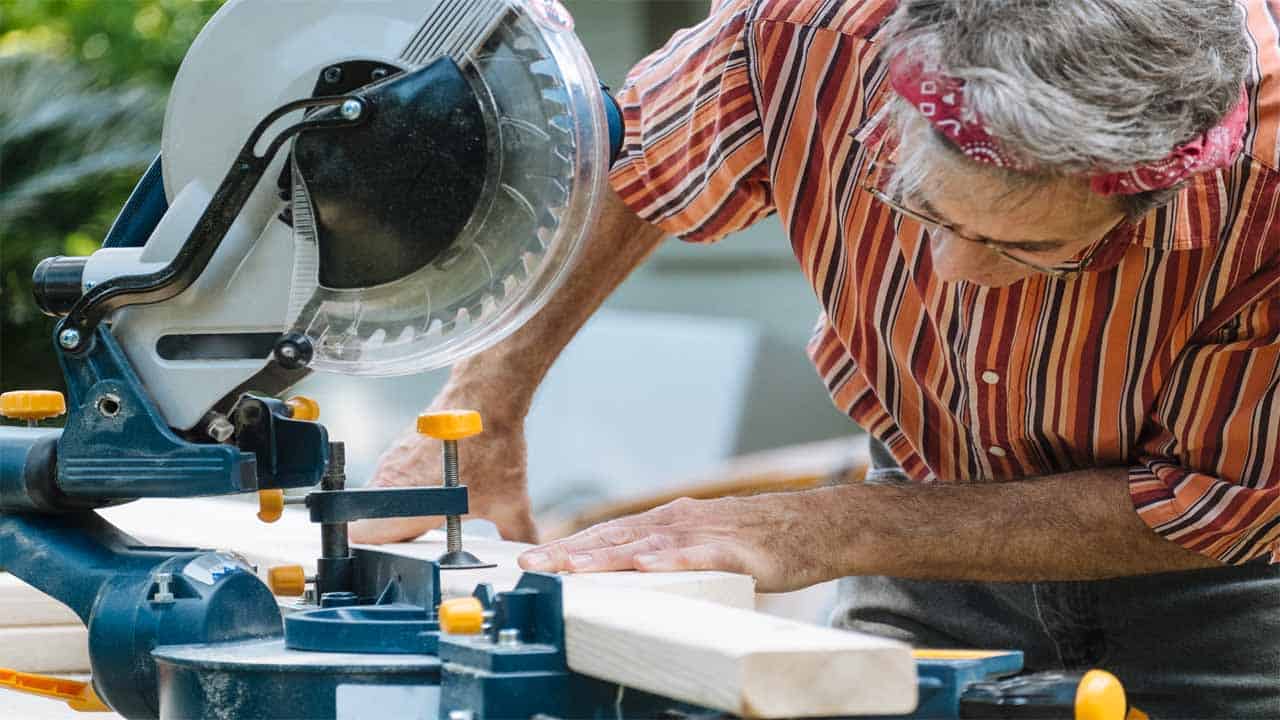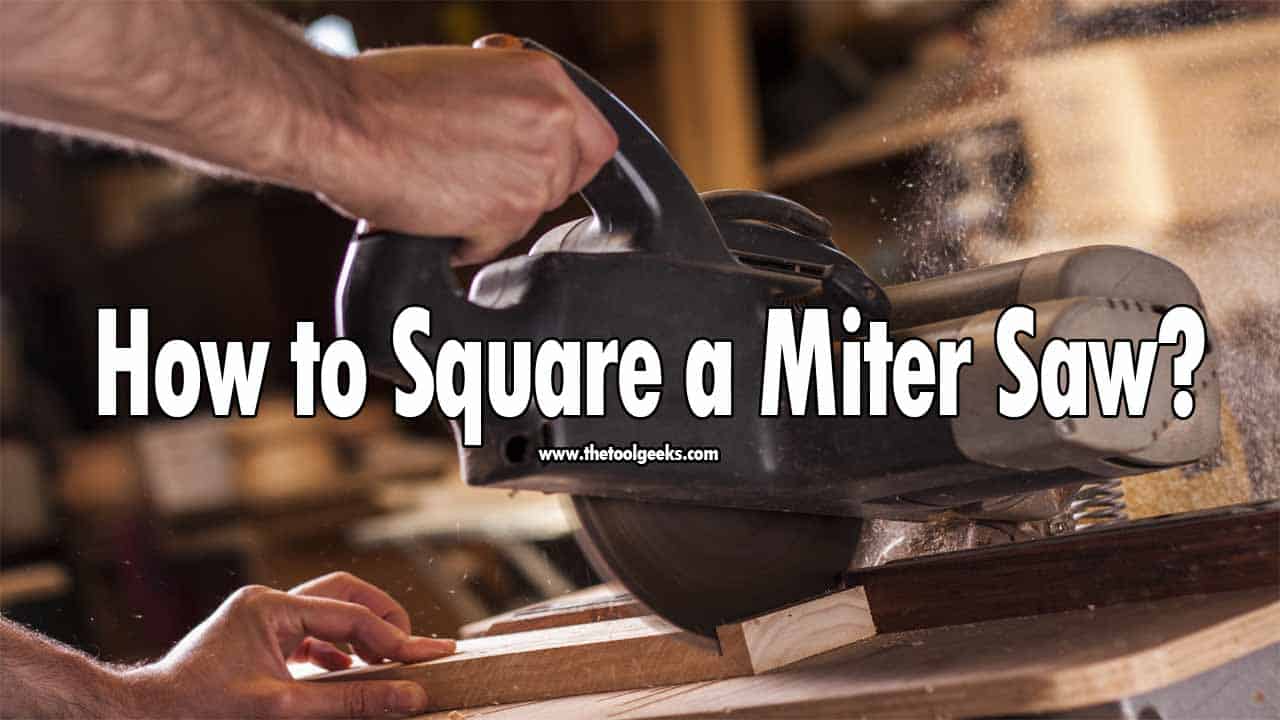How to Square a Miter Saw? (10 Thing You Have to Do)
TheToolGeeks.com is a participant in the Amazon Services LLC Associates Program and other affiliate advertising programs. We may earn from qualifying purchases. (Learn More).
A miter saw is designed for accurate cuttings. However, with time and through continued practice, shifting your saw from one place to the next, cutting a range of various types of materials, and any number of other factors can lead to tossing your miter saw of the alliance.
Some miter saws even reach to you misaligned. But don’t sweat – in this article, we are helping you to learn how to square a miter saw yourself without asking for any professional help. Continued practice with your miter saw is the key to square it with precision.
If you are using the contractor-blade saw that came out of the box with the saw, we suggest you upgrade to one more appropriate for woodworking.
Pick a blade with a negative hook angle to avoid climbing during the procedure. For a 10” blade you will need 60-80 teeth, and you will need 80-100 teeth for a 12” blade. These high tooth bets deliver splinter-free edges during crosscutting and mitering. If your miter saw doesn’t cut square or straight, follow these steps:
Jump To Page Contents:
How to Square a Miter Saw?

1. Clear the Saw
Sawdust and other junk can engraft in your saw, and your miter saw gets clogged up – which will conduce to the poor alignment of your saw.
Regular cleaning of your saw is essential after every use; now is a perfect time to begin this habit. An air compressor with an air nozzle on the end of the hose can be the ideal tool to clean the saw and blow away debris or any kind of trash from the saw.
A shop vac can also help this; it can blow away the massive amount of sawdust. Then clean up the entire saw with clean cotton fabric for better working. Also, make sure that you wipe down any pitch gird.
Related Read — Battery-Operated Miter Saw Review
2. Check the Blade
Before you align your saw again, take a look at the blade and check it’s working. Make sure it’s properly clean, and then make it more sharp and precise if it looks dull before moving on to the next step. A stain remover can also work best to reduce or get rid of any sawdust/ tar buildup.
3. Arrange Your Table
People who use the miter saw in their routine work have them arrange a saw table or a worktable. While the table itself doesn’t easily come out of alignment, but with time, a great deal of usage and usual old age can add to abrupt misalignment.
Still, you can check this by placing a straight boundary on the table to observe how it meets up to your requirements. If it is a misbalance, you might replace that area of wood or just add a small lodge to make it plane once again.
Related Read — How To Cut Baseboard With a Miter Saw
4. Adjust Your Fence
After arranging/setting up your table, you should adjust the fence for the proper working of your compound miter saw. The fence’s purpose is to support longer material during cutting, and it can be seen at the back end of the table.
By only positioning a straight edge by the fence’s length, you can spot regions where it is not appropriately aligned and not squared.
If you find any areas not aligned, loosen the screws that hold it properly and reset until it is squared. Once you are satisfied with the position, fasten the screws. Both sides will need to be squared independently as they will not be adjusted the same otherwise.
Related Read — Miter Saw vs Chop Saw
5. Fix Your Miter Angles
Now the next step is; adjusting your miter saw’s angles. First of all, you will fix the blade’s level angle to 0 degrees, and then you will adjust the miter angle to zero degrees.
The miter must square with it. The next step is, placing a combination or rafter layout square on the table and make sure this is square; confirm if one of the edges sits against the fence’s front edge.
Now, set up the saw to the scummiest possible blade position, and slide the square to the side boundary of the blade – you might have to heighten the blade guard to get this.
At this stage, the square’s border must be flat against the edge of the blade through the other side sits firmly against the fence. Look for any spaces between the fence and the blade.
If you see any gaps, lose the miter a little and tight the knob. Make little adjustments to the miter angle until the fence and the blade are square to each other, and relax the screws in the detent plate to fix to zero degree point.
Related Read — How to Cut Crown Molding With a Traditional Miter Saw?
6. Set Up Your Bevel Angel
Find out the bevel angle. It doesn’t matter if you have a compound miter saw or a basic miter saw; you just need to be concerned about adjusting your zero-degree angle square and the table with each other.
Put the square on its border with one corner facing upward from the table and the other corner in a flat position on the table. Put down the saw blade with the heightened guard.
The blade should be moved towards the blade until the blade, and the vertical edge is lined up to each other.
Notice that if there are any spaces/ room left between the blade and the square. If there are, make the bevel adjustment knob a little less tight and twist to fix the bevel. Make the knob tighter to keep the angle stiff. You can also move the bevel detents to harmonize with your particular saw mode.
Related Read — 10-inch Miter Saw Review
7. Test for Precision
After doing all of these settings, you will then ensure accuracy by testing it out. Flex the miter saw on and with a broad piece of junk board and create a crosscut at zero degrees miter.
Then use a level or square to check the precision. If it is still making the perfect cut, you will have to repeat the procedure once again.
8. Turn Your Miter Saw
Make sure that your blade is set 90 degrees to the base of the saw. Adjust the handle of a good quality square on the bottom of the saw with the square’s blade against the saw-blade body and not the teeth.
Manual can help adjust and set the stops the bevel of the saw post to avoid any spaces between the square and the blade.
Then set the cursor at the back of the saw to zero-degrees. Perform this step once again to adjust the bevel at 45 degrees. Once after setting the blade, make adjustments with the knobs and stops of the saw’s miter.
Set the blade at 90 degrees to the fence and then make settings according to the type of fence you have. If you have a one-piece fence, make the bolts or screw a little less tight on every side of the fence and adjust either side of the blade to its body. You only have to fix one side because this automatically adjusts the polar side.
9. Aligning a Two-piece Independent Fence
If the miter saw you’re using has disjoined fences, adjusting every side square to the blade may lead to fences that do not line up with one another.
The ideal way is; squaring one fence to the blade and readjusting that fence’s screws and bolts. Then, adjust the opposite fence and, in the last, set the cursor to zero degrees.
10. Setting Up a Fixed Fence
You cannot adjust the fence for some saws, so you somewhat adjust the blade and saw carriage square according to the fence.
Adjust your fence by fixing the miter at zero-degree detent and then make the screws less tight on the miter detent plate. Turn out the table to put the blade 90-degrees to the fence. Then, readjust the screws and tighten them—no need to adjust any other settings.
11. Do It
The straight test of your performance is to cut 45-degree miters at every end of four equal-length portions of stock and observe the fit by dry-clamping all pieces into a square.
A less-than-ideal joint at any edge means you’ll need to check every adjustment step and correct it as required. Keep in mind; miters draw the eye. With good focus and careful alignment, yours will draw many looks with appreciation.
FAQ’s About Squaring a Miter Saw
1. Why Does My Miter Saw Not Cut Straight?
The major reason why your miter saw might not cut straight is its lack of power to perform or crack the material down. The machine is designed to clout the material towards the blade during the cutting, and if there is malfunctioning in this procedure, it might cause inaccurate cuts.
2. Can a Miter Saw Make a Straight Cut?
Power miter saws are ideal for making cuts for rafters, trim work, molding, and other general carpentry applications. It makes a straight crosscut and, when fitted with the correct blade. The miter saw’s versatility is another part of a tool arsenal for DIYers and professional carpenters.
3. Why Are My Miter Cuts Off?
Normally if you can’t get the miter joint to snug appropriately, it’s because either you cut one part too short or too long, or the blade was not adjusted to 90 degrees. That would basically make it a compound angle cut, even though you didn’t want it.
Conclusion
While cutting with a miter saw, make sure to put your material against the vertical wall or fence. This will make sure that your cuts are precise and your material will not move.
Don’t keep your hand closer to the blade, and never cross your arms in front of your miter saw. If the part you are holding is on the right side, use your left hand to cut.
Amazon and the Amazon logo are trademarks of Amazon.com, Inc, or its affiliates.

